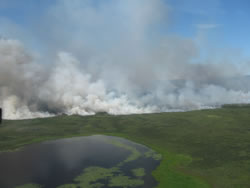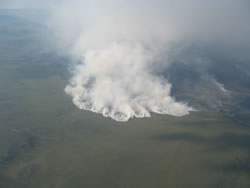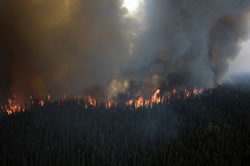
National Fire Plan Success Story
Alaska Tops Wildfire Acreage for Service in 2009
U.S. Fish and Wildlife Service, Alaska
National Fire Plan - Firefighting
2010

The Little Black One Fire burns actively in mid-July on the Yukon Flats National Wildlife Refuge in Alaska. Credit: U. S. Fish and Wildlife Service.

The Big Creek Fire burns on Yukon Flats National Wildlife Refuge achieving multiple resource benefits. Credit: U. S. Fish and Wildlife Service.

The flaming front of the Shanta Creek Fire moves through beetle-killed timber on Kenai National Wildlife Refuge. Credit: U. S. Fish and Wildlife Service.
The summer of 2009 kept firefighters busy at the national wildlife refuges in Alaska. By summer’s end, 72 fires had burned over 759,000 acres across the refuges in Alaska amounting to 93 percent of the total wildfire acreage burned for the entire U.S. Fish and Wildlife Service for 2009. Many of the Service acres burned in Alaska were landscape-level fires managed to burn as they naturally would have to provide the best benefit to resources by enhancing and protecting habitat. Full suppression actions such as direct fireline construction, use of aircraft, and use of other heavy equipment were taken on portions of the fires where communities were at risk of having fire burn structures, private property or other infrastructure. The flexibility for refuge managers and firefighters to choose the best approach for managing the fire was due in part to the revised federal fire policy guidance allowing a fire to be managed for multiple objectives as appropriate.
Multiple fires started as scattered lightning moved across the boreal forest of the 9 million acre Yukon Flats National Wildlife Refuge in June. These active thunderstorms started 9 large fires during a prolonged period of hot and dry weather. The fires subsequently burned over 400,000 acres on Yukon Flats with an additional 115,000 acres burning on other national wildlife refuges in northwest Alaska.
Simultaneously at Kenai National Wildlife Refuge in south-central Alaska, 10 significant fires also ignited due to lightning. The most notable of these was the Shanta Creek fire, which burned over 13,000 acres on the refuge. The Shanta Creek Fire started in beetle-killed spruce stands during late June near the community of Soldotna, Alaska.
The Shanta Creek fire was initially managed for resource benefit to clean out some of the forest affected by spruce bark beetle. When the fire began to move toward private lands after the first week of July, a National Incident Management Organization (NIMO) Team comprised of fire managers from across the nation was ordered to assume command of the incident. Fire management efforts then involved over 400 firefighting personnel, air tankers, and helicopters to prevent the fire from spreading into Soldonta while still allowing the fire to benefit overall forest health in places where the fire posed no threat to private property. Fortunately cooler and wetter weather moved into the area in mid-July and further slowed the growth of the fire helping firefighters.
Fires continued to burn from June to October, which is typical for fires in Alaska due to the fuel characteristics and day length. By the end of the summer, fire served as an important natural force to renew growth and overall health in the boreal forests of Alaska. The natural areas and wildlife unique to Alaska are adapted to periodic fire. The weather, with unusually long dry periods and active thunderstorms, allowed landscape-level fires in Alaska to burn longer over larger areas. While not a record fire year for Alaska, the 2009 acreage burned was well above average for the Service lands in Alaska.